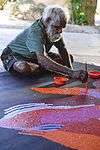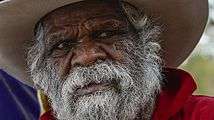Yannima Tommy Watson
Yannima Tommy Watson known as "Tommy Watson" is a senior Pitjantjatjara man from Australia’s central western desert who has become a significant contemporary Indigenous Australian artist. He was born circa 1930s[1][2] some 75 km west of the tiny isolated community of Irrunytju.
| Yannima Tommy Watson | |
|---|---|
|
Tommy Watson 2013 | |
| Born |
Yannima Pikarli Circa 1935 Anamarapiti, Western Australia |
| Known for | Painting |
| Movement | Contemporary Indigenous Australian art |
Life
Tommy Yannima Pikarli Watson was born around 1935 west of the community of Irrunytju,[3] also known as Wingellina, in Western Australia, near the junction of its border with the Northern Territory and South Australia.
Tommy Watson is a senior Pitjantjatara elder and Law man of Karima skin group. His given names of Yannima and Pikarli relate to specific sites near Anumarapiti, located 75 Kilometers West of the small community of Irrunytju (near the tri-state border of Western Australia, South Australia and The Northern Territory). Tommy unfortunately has no recollection of his mother who died during his infancy; however he does remember his father who also unfortunately died when Tommy was about eight years old. Tommy subsequently went to live with his father's brother who then sadly died two years later. Following this series of unfortunate deaths within his family Tommy was then adopted by Nicodemus Watson, his father's first cousin. It was at this point that Tommy went to live at Ernabella Mission, and decided to take the surname Watson in addition to his Aboriginal birth name thus becoming Tommy Yannima Pikarli Watson.
Nicodemus Watson proved to be a strong father figure, teaching a young Tommy the traditional skills of hunting and gathering required to lead a nomadic existence in the harsh terrain of the Australian desert. They traveled great distances from Ernabella through the Musgrave Ranges and onwards toward the Petersham Ranges. Tommy learned key skills required for survival in such a hostile climate including, but not limited to, the fashioning of tools and weapons from trees using burning coals, how and what to hunt, and most importantly how and where to find water. In this harsh and ancient country, under the guidance of his adopted father Nicodemus Watson, Tommy gained a deep understanding of his physical environment and its relationship to his own ancestral stories. To the Aboriginal peoples of Australia these ancestral stories are collectively known as Tjukurrpa,[2]
Tommy Watson's first contact with white Australians was when he was sent to school at the Ernabella Mission which opened in 1940. Tommy was not at Ernabella for long before he was taken back to his community to be initiated. Tommy Watson's upbringing is similar to that of many Indigenous people born around the same time, from that point forward living a traditional nomadic existence until his early teens and working as a stockman and labourer. During his time working at Papunya he met the school teacher Geoffrey Bardon who was pivotal in supporting the developing Aboriginal Art movement.[4]
Art
Tommy Watson began painting in 2001, at the same time becoming one of a handful of painters establishing the Irrunytju community art centre in 2001,[2] soon after being identified as a leading light in the Aboriginal Art movement,[1] and is held in high esteem both nationally and internationally.
Tommy Watson's use of strong vibrant colours such as oranges, burgundies, reds, ivory, blues, pinks (and more recently highlights of green) create unfettered, sumptuous and complex compositions that symbolically represent the stories embedded in his country. Judith Ryan, Senior Curator of indigenous Art at the National Gallery of Victoria, has described Watson's colour as 'incandescent'. Watson's colour palette is applied decisively, creating a dramatic impact through his various combinations of hues and the seeming subtlety of his depictions of Dreamings. The large shimmering layers of dots in bright pinks, whites, yellows, oranges, reds, purples, blues and greens that surge in waves across the canvas enable one to view the landscape as a topography shaped by its cultural importance. In this harsh and ancient country, through the guidance of his father, Watson gained a deep understanding of his physical environment and its relationship with the ancestral stories, collectively known as Tjukurrpa,[2] which have come to form the central element of his paintings. Watson currently prefers to execute his works on premium Belgian linen and favours Ara Acrylic paint, created by the Gerrit Rietveld Academy. Tommy has been associated with the 'Colour Power' movement that developed within the Indigenous art scene in the decades between 1984 and 2004.[5]
The impact of Tommy Watson's work on non-Indigenous viewers could be described in terms outlined by Roger Lipsey, the eminent New York art historian, in a discussion on the spirituality in art - 'The greatest art melts and remakes us - not literally, of course, but inwardly: not permanently, but for long enough to impart the taste of a quite different state of being. Later one can't help thinking about art that had such impact, to the point that it may alter one's view of human identity. By the light of such art we appear to be veiled and distanced from our own core, yet at that elusive core endowed with elemental energy'[6]
Watson himself has provided rare insight into his exploration of traditional Aboriginal culture, in which the land and scared spirituality are intertwined and communicated through Dreamings passed on from generation to generation. “My grandfather’s country, grandmother’s country. When they were alive, they would take me around the country, when I was a kid. That dreamtime country. That’s why we look after the country, go out whenever we can, see if the rock-holes are good.”[2] I want to paint these stories so that others can learn and understand about our culture and country.[2]
Watson's work has received critical acclaim, both within Australia and internationally, with art critics drawing parallels between Watson and the great Western Abstractionists Wassily Kandinsky, Piet Mondrian, Kasimir Malevich, Mark Rothko and Barnett Newman for whom spiritual reference was very important. Kandinsky believed that ' ..words, musical tones and colours possess the physical power of calling forth soul vibrations. They create identical vibrations, ultimately bringing about the attainment of knowledge.[7] John MacDonald wrote of Watson's work in the Sydney Morning Herald 'Watson is a master of invention and arguably the outstanding painter of the Western Desert. Each painting tells a specific story, but the most impressive feature is the artist's use of colour. Like Matisse, Watson knows that one may have warm and cool shades of red, warm and cool shades of blue. but he knows this instinctively, without any formal training. What he knows cannot be verbalised, and cannot be taught, yet no one could see these paintings and not be convinced of their profundity.'
In 2003 Watson was one of eight Indigenous artists, alongside Paddy Bedford, John Mawurndjul, Ningura Napurrula, Lena Nyadbi, Michael Riley, Judy Watson and Gulumbu Yunupingu, who collaborated on a commission to provide works that decorate one of the Musée du quai Branly's four buildings completed in 2006.[8]
Watson returned to the desert in early 2013 to reside with family in Alice Springs in the Northern Territory. Following a marked improvement in his health after returning to the desert Watson began painting with a renewed sense of purpose; producing monumental works up to five meters long in his own distinctive style. Watson is currently represented commercially by Yanda Aboriginal Art and Piermarq,[9] with monumental canvases produced at Yanda Aboriginal Art in 2013 seeing prices in excess of $800,000 each. Most notably, one particular work, titled Ngayuku Ngura - Anumara Piti, sold for around $500,000 through Sydney's Piermarq gallery to prominent Sydney businessman Andrew Wise.[10]
In Watson's more recent career developments, 2014 has seen a major work of 160 x 485 cm by Tommy Watson exhibited at TEFAF (The European Fine Art Fair[11]), one of the world's most prestigious art fairs. Watson's work was also on display as part of a group exhibition consisting solely of First Contact Western Desert Masters including Tommy Yannima Pikarli Watson, Naata Nungurrayi, Esther Giles Nampitjinpa, and George Hairbrush Tjungurrayi at the Piermarq gallery in Sydney in June–July 2014.
In 2014 the Art Series Hotel Group[12] named Watson as the first Indigenous artist to feature in the collection.[13] Located in Adelaide, his namesake hotel The Watson features a collection of high-quality reproduction prints.[14]
Artwork
 Tommy Watson, painting at Yanda 2013
Tommy Watson, painting at Yanda 2013 Tommy Watson, Major Work in Country 2013. The Australian
Tommy Watson, Major Work in Country 2013. The Australian Tommy Watson ‘Ngayuku Ngura – Anumara Piti - My Country’.160 x 488 cm, SMH & The AGE 28/08/2013
Tommy Watson ‘Ngayuku Ngura – Anumara Piti - My Country’.160 x 488 cm, SMH & The AGE 28/08/2013
Collections
- Art Gallery of New South Wales
- National Gallery of Australia[3]
- National Gallery of Victoria[3]
- Musee du Quai Branly, Paris[8]
- Art Gallery of Western Australia
- South Australian Art Gallery
- Museum and Art Gallery of the Northern Territory
- Colin Laverty, Collection
- Patrick Corrigan, Collection[15]
- Auscorp Collection
- Kerry Stokes Collection
Collections artwork links
- Wulpa 2004, Art Gallery of NSW
- Walpa 2002, National Gallery of Australia
- Awilyulu 2003, National Gallery of Victoria
Notes
- 1 2 John McDonald (2005-11-24). "The Australian Way - December - Art" (pdf). Qantas. Retrieved 2007-11-21.
BORN C1930-32. WARAKURNA, WA. Since emerging in 2002, Tommy Watson has arguably become the greatest living painter of the Western Desert
page 56 - 1 2 3 4 5 6 "Agathon Galleries". Archived from the original (pdf) on 2007-09-14. Retrieved 2007-11-21.
Born: c1935 at Anamarapiti
- 1 2 3 McCulloch, Alan; Susan McCulloch; Emily McCulloch Childs (2006). The new McCulloch's Encyclopedia of Australian Art. Fitzroy, VIC: Aus Art Editions in association with The Miegunyah Press. p. 179. ISBN 0-522-85317-X.
- ↑ Yannima Pikarli Tommy Watson. Ken McGregor, Marie Geissler, Flore Gregorini Macmillan ISBN 978-1-921394-43-0
- ↑ Judith Ryan Colour Power:Aboriginal Art Post 1984, in the collection of the National Gallery of Victoria, National Gallery of Victoria Melbourne Vic 2005 p 112
- ↑ Roger Lipsey, Sacred Art Without Credentials in Nick Waterlow and Ross Mellick eds, Spirit and Place Art in Australia 1981-1996 Museum of contemporary Art Sydney Australia 1996 p74
- ↑ Maurcice Tuchman 'Hidden Meaning in Abstract Art ' in Edward Weisberger The Spiritual in Abstract Art , Los Angeles County Museum California and Abbeville Press inc New York 1987 pp34-35
- 1 2 Claire Armstrong, ed. (2006). Australian Indigenous Art Commission: Musee du quai Branly. Eleonora Triguboff, Art & Australia, and Australia Council for the Arts. ISBN 0-646-46045-5.
- ↑ http://www.piermarq.com.au/tommy-Watson-register/
- ↑ http://www.theaustralian.com.au/arts/visual-arts/three-way-battle-over-western-desert-artist-tommy-watson-not-a-pretty-picture/story-fn9d3avm-1226762144842#
- ↑ http://www.tefaf.com/
- ↑ http://www.artserieshotels.com.au/
- ↑ Kumurdian, Dijana. "Art Series Hotels to open The Watson in Adelaide". http://www.vogue.com.au/vogue+living/. Vogue Living Australia. Retrieved 30 January 2015. External link in
|website=(help) - ↑ http://www.artserieshotels.com.au/watson/
- ↑ Patrick Corrigan (businessman)
External links
- Example of Tommy Watson's work, National Gallery of Australia
